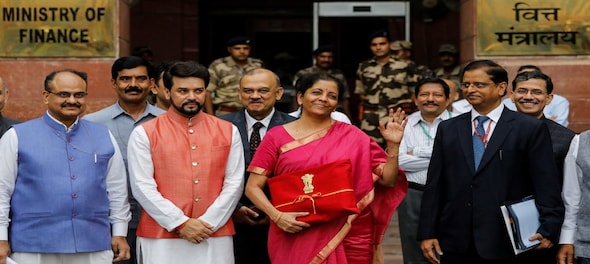
Finance minister Nirmala Sitharaman in her maiden budget speech has delivered a growth-oriented and job-oriented blueprint for the economy to promote overall growth and consistent job creation.
The Union Budget, the first by the Narendra Modi government in its second term, has outlined several new reform initiatives like big privatisation push, relaxation of norms for foreign portfolio investors, further liberalisation of foreign direct investment (FDI) policy, a new policy on rental housing and most importantly incentives for faster adoption of next generation technologies such as electric vehicles. It is investment that drives demand, creates capacity, increases labour productivity, develops new technology, and generates jobs.
The Budget advocates policies via four pillars of thrust, that can push the Indian economy to $5 trillion mark — in sync with Prime Minister Modi’s vision.
The first pillar continues to focus on increasing investment led by government spending. There is a big push for infrastructure spending, promotion of rental housing, simplification archaic rental laws, significant role for private players in railways, introduction of "one nation one grid" for affordable power, proposal to have gas and water grids and infrastructure spending to the tune of Rs 50,000 crore between 2018 and 2030 for railways.
The budget proposes further opening of FDI in aviation sector, media, animation AVGC and insurance sectors in consultation with all stakeholders. Hundred percent FDI will be permitted for insurance intermediaries.
The Budget emphasises on removing critical bottlenecks that hinder the growth of the economy in the second pillar of growth. For ease of access to credit for MSMEs, the government has introduced providing of loans up to Rs 1 crore for MSMEs within 59 minutes through a dedicated online portal. Creation of a payment platform for MSMEs to enable filing of bills and payment thereof on the platform itself will play a vital role to eliminate delays in payment.
This Budget reinforces the important role that non-banking financial companies (NBFCs) and housing finance companies (HFCs) play in credit delivery. Steps have also been introduced to allow all NBFCs to directly participate on the Trade Receivables Discounting System (TReDS) platform. A number of measures have also announced been to enhance liquidity access for NBFCs by permitting investments made by foreign investors and continue getting funding from banks and mutual funds.
The primary challenge facing the government is jobs, and the third pillar focuses on jobs creation and type of jobs for the future. This issue is addressed with focus to increase new-age skills like Artificial Intelligence (AI), Internet of Things (IoT), big data, 3D printing, virtual reality and robotics, which are the future.
Eighty livelihood business incubators and 20 technology business incubators to develop 75,000 skilled entrepreneurs in agro-rural industries will help in alleviating concerns in agriculture and rural economy. The Budget also envisions the government's efforts to make India a global hub of manufacturing of electric vehicles (EVs), solar storage batteries and charging infrastructure. Efforts to simplify compliance and taxation for startups are also addressed. There are also several measures to promote digital payments further.
In the fourth pillar, the finance minister has rolled out a number of steps to boost core areas such as agriculture, healthcare, education, social welfare and rural development. The budget proposes a novel “social stock exchange” for social enterprises and voluntary organisations working for social welfare so that they can raise capital through debt, equity or mutual funds.
The government will extend pension benefits to three crore retail traders and shopkeepers who have a revenue of less than Rs 1.5 crore.
A number of measures for capital markets and International Financial Services Centre (IFSC) in consultation with regulators have also been proposed. Interoperability of the Reserve Bank of India (RBI) depositories and the Securities and Exchange Board of India (Sebi) depositories for seamless transfer of treasury bills, investor-friendly norms, measure to deepen the corporate bond market and corporate tri-party repo market, disinvestment and several tax benefits for IFSC.
With FY2020 fiscal deficit target cut to 3.3 percent from 3.4 percent, the finance minister has kept the government’s fiscal consolidation track record intact and used a variety of measures to bolster the government’s revenue efforts. Overall, this is a positive budget, with continued focus on fiscal prudence, boosting infrastructure, augmenting Micro, Small and Medium Enterprises (MSMEs) and NBFCs, improving skill development and focus on next generation technologies.
The Modi government in its first term was largely focused on repairing the stressed banking system and undertaking structural economic resets. Despite this, not only has the economy registered high growth rates but also ensured low inflation and adherence to fiscal prudence.
India has been a bright spot in the global economy, growing faster than all major economies in the last few years. In its second term, the expectation was that the Modi government will propel the economy and break away from the barriers holding it back. In this regard, the finance minister, in her maiden budget, has taken some bold measures.
The budget is growth oriented, spurs private investment, keeps government’s fiscal consolidation track record intact and uses a variety of methods to bolster the investment cycle led by government spending.
Ashish Chauhan is the current managing director and chief executive officer of the Bombay Stock Exchange.
First Published: Jul 5, 2019 8:27 PM IST
Check out our in-depth Market Coverage, Business News & get real-time Stock Market Updates on CNBC-TV18. Also, Watch our channels CNBC-TV18, CNBC Awaaz and CNBC Bajar Live on-the-go!


PM Modi visits Ram Mandir for first time since 'Pran Pratishtha', offers prayers before roadshow
May 5, 2024 8:59 PM
Visiting temples, obliging selfie requests, jabbing rivals – Kangana Ranaut is wooing voters on campaign trail
May 5, 2024 8:23 PM

